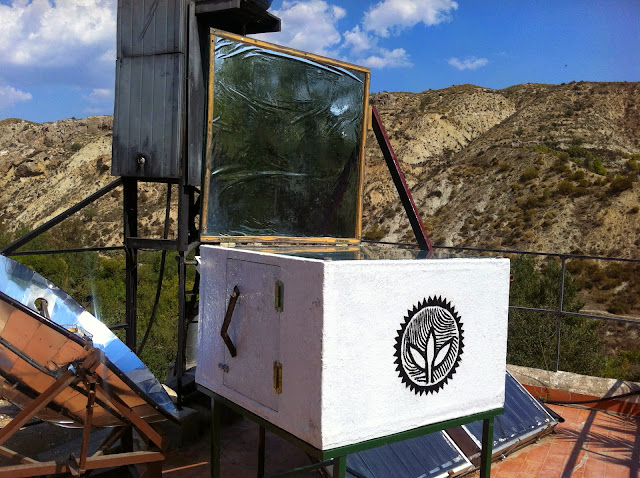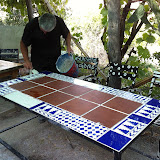Sunseed News
Appropriate Technology Dept. Sunseed activities September 2013
by Pako Ibáñez, Appropriate Technology Department coordinator at Sunseed.
This month we completed the pending projects.
The biomass cookstove base structure has been reinforced and has been transported to the main house where it will be used. We started to cook usually, demonstrating that whatever can use it, has a very simple operation and is very efficient. We’re burning cane and almond shells. In short will be prepared other fuels. 2 hours of heat, are easily obtained. The gasification is very good, and does not generate smoke, so can be used perfectly to the side of the house.
We also have built a structure to support the solar oven with turning wheels that allow to point towards the sun. The box has been coated with fiberglass to protect it from the elements and painted white, to reject the sun’s heat on the outside. At noon you reach 144 degrees celsius, allowing to cook many dishes perfectly.
 por Pako Ibáñez, coordinador del Departamento de Tecnología Apropiada de Sunseed.
Este mes hemos finalizado los proyectos pendientes.
A la cocina de biomasa le ha sido reforzada la estructura de la base y ha sido transportada a la casa principal donde va a ser utilizada. Hemos empezado a cocinar habitualmente en ella, demostrando que cualquiera la puede utilizar, que tiene un funcionamiento muy sencillo y que es muy eficiente. Estamos quemando caña y cáscara de almendra. En breve se prepararán otros combustibles. Se obtienen fácilmente 2 horas de fuego fuerte. La gasificación es muy buena, y al no generar humo, se puede utilizar perfectamente al lado de la casa.
Al horno solar también se le ha construido una estructura para sustentarlo, con ruedas que permiten girarlo para orientarlo hacia el sol. El conjunto ha sido recubierto con fibra de vidrio para protegerlo de la intemperie y pintado de blanco, para rechazar el calor del sol por la parte exterior. Al mediodía se alcanzan los 144 grados celsius, con lo que se pueden cocinar perfectamente muchos guisos.
por Pako Ibáñez, coordinador del Departamento de Tecnología Apropiada de Sunseed.
Este mes hemos finalizado los proyectos pendientes.
A la cocina de biomasa le ha sido reforzada la estructura de la base y ha sido transportada a la casa principal donde va a ser utilizada. Hemos empezado a cocinar habitualmente en ella, demostrando que cualquiera la puede utilizar, que tiene un funcionamiento muy sencillo y que es muy eficiente. Estamos quemando caña y cáscara de almendra. En breve se prepararán otros combustibles. Se obtienen fácilmente 2 horas de fuego fuerte. La gasificación es muy buena, y al no generar humo, se puede utilizar perfectamente al lado de la casa.
Al horno solar también se le ha construido una estructura para sustentarlo, con ruedas que permiten girarlo para orientarlo hacia el sol. El conjunto ha sido recubierto con fibra de vidrio para protegerlo de la intemperie y pintado de blanco, para rechazar el calor del sol por la parte exterior. Al mediodía se alcanzan los 144 grados celsius, con lo que se pueden cocinar perfectamente muchos guisos.
 To finish the biomass stove, Lucia has spent many hours in the workshop. We reinforced the support structure, soldering metal tubes which connect the legs at mid-height. The last touch was to paint the part to be heated with thermal paint, and legs with outdoor paint.
We made several tests to cook. Remember that the system allows you to cook with a pan while we put the excess of heat into the oven, getting getting easily a temperature of 200 degrees, and can be used for another preparation. We baked cakes, lasagna, pizza and various vegetables with great success.
7-8 cm long cane chunks were used as a fuel, also almond hulls and wood scraps. Flame time depends on the amount and type of fuel with which filled the gasifier, in this case, the Kañon!!!. with half load of almond shells (about 4kg.) last for about 2 hours. With a whole load of cane (about 4 kg.), the flame time is about 40 minutes. A mixture of both, gives 1 hour combustion. With pieces of scrap wood, you get very good times too. In the gasifier flame concentrator, the temperature is about 1000 degrees Celsius.
As residential kitchen allows boiling the biggest pots available in Sunseed (for 40 portions of food) without any problem and quickly. The system must be improved to reduce the heat input into the pot, it can be excessive for dishes that require slow cooking.
For those applications where you need a long cooking time and using the gas stove is less sustainable and very expensive, this device reveals essential. Canning, making jams, syrups, cooking vegetables, etc., are carried out with completely renewable fuel, free and local.
I want to remember and dedicate the project to the volunteer who initiated, Alexis, that permeated the cookstove of good energy and enthusiasm.Thank you!
To finish the biomass stove, Lucia has spent many hours in the workshop. We reinforced the support structure, soldering metal tubes which connect the legs at mid-height. The last touch was to paint the part to be heated with thermal paint, and legs with outdoor paint.
We made several tests to cook. Remember that the system allows you to cook with a pan while we put the excess of heat into the oven, getting getting easily a temperature of 200 degrees, and can be used for another preparation. We baked cakes, lasagna, pizza and various vegetables with great success.
7-8 cm long cane chunks were used as a fuel, also almond hulls and wood scraps. Flame time depends on the amount and type of fuel with which filled the gasifier, in this case, the Kañon!!!. with half load of almond shells (about 4kg.) last for about 2 hours. With a whole load of cane (about 4 kg.), the flame time is about 40 minutes. A mixture of both, gives 1 hour combustion. With pieces of scrap wood, you get very good times too. In the gasifier flame concentrator, the temperature is about 1000 degrees Celsius.
As residential kitchen allows boiling the biggest pots available in Sunseed (for 40 portions of food) without any problem and quickly. The system must be improved to reduce the heat input into the pot, it can be excessive for dishes that require slow cooking.
For those applications where you need a long cooking time and using the gas stove is less sustainable and very expensive, this device reveals essential. Canning, making jams, syrups, cooking vegetables, etc., are carried out with completely renewable fuel, free and local.
I want to remember and dedicate the project to the volunteer who initiated, Alexis, that permeated the cookstove of good energy and enthusiasm.Thank you!
 El horno solar ha sido también finalizado, instalado en el techo solar de la casa principal y puesto en marcha. Al equipo compuesto por Magued y Simón, se unieron María, Julia, Mukund y Lucía, con lo que la parte final del proyecto estuvo cargado de buena energía y mejores ideas.
After placing the double glazing at the sunshine entrance to create a thermal break to prevent heat from escaping trough the top, we proceeded to coat glass fiber outside the furnace to make it weatherproof and give long durability. We used a chemical that could be described as unsustainable and aggressive. To decide this, we considered the following factors:
El horno solar ha sido también finalizado, instalado en el techo solar de la casa principal y puesto en marcha. Al equipo compuesto por Magued y Simón, se unieron María, Julia, Mukund y Lucía, con lo que la parte final del proyecto estuvo cargado de buena energía y mejores ideas.
After placing the double glazing at the sunshine entrance to create a thermal break to prevent heat from escaping trough the top, we proceeded to coat glass fiber outside the furnace to make it weatherproof and give long durability. We used a chemical that could be described as unsustainable and aggressive. To decide this, we considered the following factors:
- By doing weatherproof (heat, cold, rain …), its duration will be longer than the existing solar ovens, whose wood is degraded rapidly over the months.
- Fiberglass is a further insulating layer. In this case protects the outside of the wooden sandwich from hot sun. Being white painted increases this effect by reflecting more sunlight.
- The cost is much lower compared to change the wood when degrade.
- Has a structural reinforcement effect that makes it virtually unbreakable.
 These two projects have earned a special video each.
Also are available the photo albums of both projects:
These two projects have earned a special video each.
Also are available the photo albums of both projects:
 |
| Sunseed AT Gas-Bio Septiembre 2013 |
 |
| Sunseed AT Solar cooker |
 |
| Sunseed AT Septiembre 2013 |
 |
| Sunseed Septiembre 2013 |
 El horno solar ha sido también finalizado, instalado en el techo solar de la casa principal y puesto en marcha. Al equipo compuesto por Magued y Simón, se unieron María, Julia, Mukund y Lucía, con lo que la parte final del proyecto estuvo cargado de buena energía y mejores ideas.
Después de colocar el doble acristalamiento en la entrada de los rayos de sol para crear un puente térmico que impida que el calor se escape por la parte superior, procedimos a recubrir con fibra de vidrio el exterior del horno para hacerlo resistente a la intemperie y darle una durabilidad larga. Cierto es que se ha utilizado un producto químico que se podría calificar de poco sostenible y agresivo. Para decidirlo tuvimos en cuenta los siguientes factores:
El horno solar ha sido también finalizado, instalado en el techo solar de la casa principal y puesto en marcha. Al equipo compuesto por Magued y Simón, se unieron María, Julia, Mukund y Lucía, con lo que la parte final del proyecto estuvo cargado de buena energía y mejores ideas.
Después de colocar el doble acristalamiento en la entrada de los rayos de sol para crear un puente térmico que impida que el calor se escape por la parte superior, procedimos a recubrir con fibra de vidrio el exterior del horno para hacerlo resistente a la intemperie y darle una durabilidad larga. Cierto es que se ha utilizado un producto químico que se podría calificar de poco sostenible y agresivo. Para decidirlo tuvimos en cuenta los siguientes factores:
- Al hacerlo resistente a la intemperie (calor, frío, lluvia…), su duración va a ser más larga que la de los hornos solares hasta ahora existentes, cuya madera se degrada rápidamente con el paso de los meses.
- La fibra de vidrio es una capa aislante más. En este caso protege a la parte exterior del sandwich de madera del calor del sol. El hecho de estar pintada de blanco posteriormente, aumenta este efecto al reflejar más luz solar.
- El coste es mucho más bajo comparado con cambiar la madera del horno cuando se degrade.
- Tiene un efecto de refuerzo estructural que lo hace prácticamente irrompible.
 Estos dos proyectos han merecido un vídeo especial cada uno.
También están disponibles los álbumes de fotos de ambos proyectos:
Estos dos proyectos han merecido un vídeo especial cada uno.
También están disponibles los álbumes de fotos de ambos proyectos:
 |
| Sunseed AT Gas-Bio Septiembre 2013 |
 |
| Sunseed AT Solar cooker |
 |
| Sunseed AT Septiembre 2013 |
 |
| Sunseed Septiembre 2013 |

